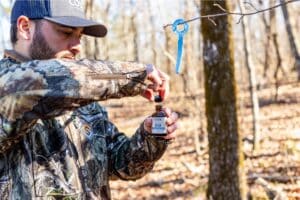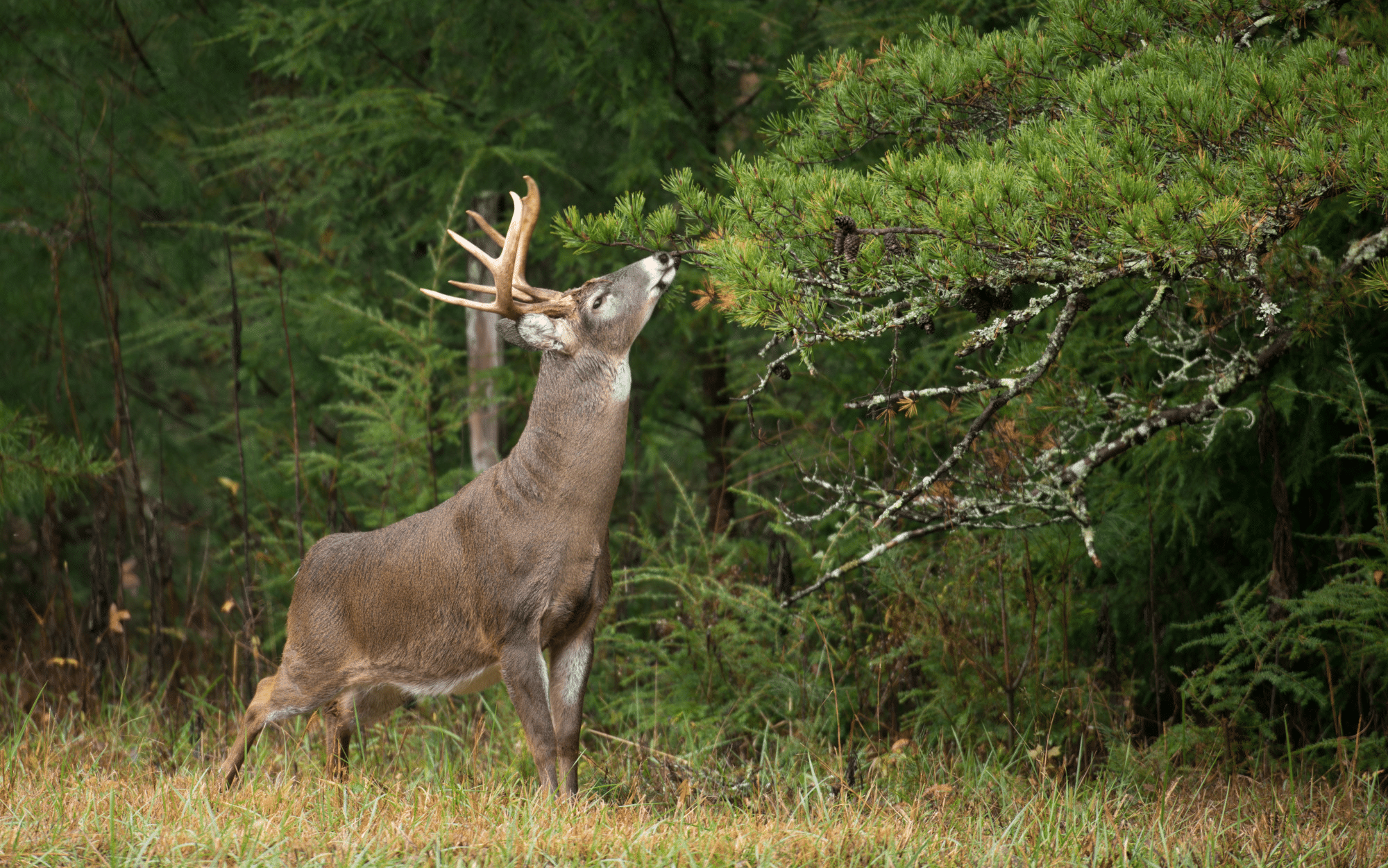5 Tips To Score During The Rut
1. Hunt The Sign And Hunt The Does
As testosterone surges in whitetail bucks, they begin to increase their hunt for the first doe to reach estrus. This equals bucks visiting doe hangouts more frequently, such as food plots, browse patches and agricultural hubs, like soybean fields. Mark every doe hangout on your Moultrie Mobile interactive map and begin monitoring them with your Moultrie Mobile cellular trail cameras.
To focus your search further, note any trails that begin to consistently stand out with new rubs. Scrapes will also begin to appear along trails used more by bucks. Lines of scrapes, like lines of rubs, indicate travel routes of bucks. A heavily used scrape along a trail with shiny, new rubs could be your first meeting point with an eager buck visiting it at dusk. Look for large scrapes visited by numerous deer. These oftentimes show up at the junction of several trails or along field edges.
2. Use Your Calls
As bucks search for estrus does in the pre-rut and hunt for the next doe to breed during the peak rut, they use clues to hook up. Vocalizations are one of the clues so keep your call handy. A call that includes grunt and bleat sounds is ideal. Even though it is tempting to strike up a grand conversation, use your calls sparingly. It’s not a musical instrument, so grunt a short cadence, rattle quick and then let the buck do the rest.
Calling too much gives deer too much information and they may detect a ruse or spook. It is best to call when animals are behind cover or moving. If you call when a buck is in plain sight of your stand he might pinpoint the sound to within a few feet.
For rattling, the rules are even more stringent. Only rattle when bucks are far away. If you rattle when bucks are less than 100 yards away, especially from a treestand, it could cause them to spook. Fights are brief, but fierce in the rut so keep the conflict short and loud when calling to distant bucks.
3. Add A Visual
When deer hear or smell another deer, they investigate. When they arrive, give them a visual to keep their presence in a shooting lane long enough for a solid shot. Decoys can be a great addition to your ambush location, but use the right decoy according to the timing of the rut. During the pre-rut bucks are enforcing territoriality and dominance. This is a good reason to use an immature buck decoy in the pre-rut for a bold reaction. You can continue to use a buck decoy during the rut, but as more and more does are bred, slowly transition to a doe decoy as bucks search for the last hookup of the year.
If you want to be mobile and deploy decoys at your discretion, nothing works better than foldable, photo-realistic decoys such as those made by the Montana Decoy Company. Remember that whitetails use the wind to approach a decoy, but approach female and male deer differently. Bucks characteristically parallel walk by each other face to face to make their bodies look as big as possible and to frighten the other. Any approaching buck attempts to keep the wind in his favor so position your decoy upwind and facing toward you at an angle. Always place a doe decoy facing away at a slight angle from your stand in an upwind position.

4. Scent of a Deer
Whitetails survive by keeping the wind in their favor. When they smell danger, they flee and when they smell another deer they may investigate. Give them something to investigate. You can disperse scent via a wick, a dripper or simply splash some on a location where you want a deer to stop in a shooting lane. I prefer bottles that mist so I can spray a layer of scent on vegetation that is nose level and in the exact place I want to pause a buck for a shot.
If you struggle with what scent to use, don’t worry. Any deer scent will get the job done. But if you hope to time your smell to the season, keep these guidelines in mind. Doe urine works anytime to reassure other deer in the area that everything is fine and deer activity is occurring nearby. Mist the urine along a trail on vegetation a nose height or hang soaked wicks at approximately 5-6 feet to allow breeze dispersion. As the pre-rut picks up steam, buck urine can entice other bucks to investigate the smell of an intruder in their territory. You can dispense scent through the same wick system or better yet, a dripper over a real or mock scrape. During breeding season estrus scent is always a winner. In the post-rut, again use estrus as bucks are looking for that last fling of the season.
5. Hunt the Odd Spots
Take an intense look around your hunting property. Are you overlooking rut hideouts, obvious and otherwise, that bucks use to keep a hot doe all to themselves? Your assessment should include the examination of isolated pockets of cover removed from a road or in the middle of a section of land.
Inspect old farmsteads, tree belts, hedge remnants, wetlands, native grasslands and gravel pits. Mature bucks that have left their normal patterns due to their selfishness for breeding and hunting pressure, seek out past refuge that hasn’t been invaded or some obscure parcel of cover you likely wouldn’t glance twice at. Any habitat that does not fit the norm is fair game for a buck hoping to have some alone time with his new girlfriend.
Rutting whitetails will continue to stump and amaze you. Even with their lack of sensibility during the rut, they can make you look like a fool. Hopefully these rut hunting tips can help you overcome their savviness during your limited time to chase them while the rut rages.
Article written by Mark Kayser. Kayser is a full-time freelance writer and co-host of the Whitetail Revolution TV show. Kayser lives in Wyoming and is a DIY public land elk hunter. After elk he spends the remainder of his fall traveling the country chasing whitetails. Learn more about Mark Kayser and follow him on Instagram @Kaysermark.


Featured
Juicy homemade jalapeno cheddar brats are perfect for grilling all summer long. They’re packed with all the right seasonings and fresh ingredients, making them extra tasty.

Featured
MeatEater and Moultrie Mobile join teams to bring hunters closer to nature.

Featured
These wild turkey skewers are tender and smothered in a homemade teriyaki glaze. Wild turkey sometimes gets a bad reputation for being a tough meat but when prepared properly using the steps in this recipe, the results are amazing.



